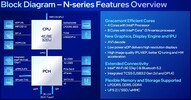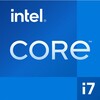Intel Processor N95 vs Intel Core i5-12450H vs Intel Core i7-12800H
Intel Processor N95
► remove from comparison
The Intel Processor N95 (sometimes also called Celeron N95 or Pentium N95) is an entry-level mobile CPU for thin and light laptops from the Alder Lake-N series. It was announced in early 2023 and offers no performance cores and 4 of the 8 efficient cores (E-cores, Gracemont architecture). The chip does not support HyperThreading and clocks with up to 3.4 GHz. The performance of the E-cores should be similar to old Skylake cores (compare to the Core i7-6700HQ). All cores can use up to 6 MB L3-cache. Compared to the similar Processor N100, the N95 offers a slightly higher TDP and therefore maybe a slightly improved sustained performance.
Performance
The average N95 in our database is in the same league as the Pentium 7505 and the Core i3-1115G4, as far as multi-thread benchmark scores are concerned. That's not a great result, to put it mildly.
Your mileage may vary depending on how high the CPU power limits are and how competent the cooling solution of your system is.
Features
The Alder Lake-N chips only support single channel memory with up to DDR5-4800, DDR4-3200 or LPDDR5-4800. The chip also supports Quick Sync and AV1 decoding (most likely same engine as in Alder Lake). Furthermore, Wi-Fi 6E and Bluetooth 5.2 are partly integrated (but no Thunderbolt). External chips can be connected via PCIe Gen3 x9 (via the PCH).
The integrated graphics adapter is based on the Xe-architecture and offers only 16 of the 32 EUs (Execution Units) operating at only 1200 MHz. Due to the single channel memory, low clock speeds, and low shader count, the gaming performance of the iGPU is very limited.
Power consumption
The N95 has a base power consumption of 12 W (compared to the 6 W of the N100) and is therefore well suited for thin and light systems. The CPU is built with a further improved 10nm SuperFin process at Intel (called Intel 7).
Intel Core i5-12450H
► remove from comparison
The Intel Core i5-12450H is a high-end mobile CPU for laptops based on the Alder Lake architecture. It was announced in early 2022 and offers 4 of the 6 performance cores (P-cores, Golden Cove architecture) and 4 of the 8 efficient cores (E-cores, Gracemont architecture) leading to 8 cores in total (octa core CPU). The P-cores support Hyper-Threading leading to 12 supported threads when combined with the E-cores. The clock rate ranges from 2 to 4.4 GHz on the performance cluster and 1.5 to 3.3 GHz on the efficient cluster. The performance of the E-cores should be similar to old Skylake cores (compare to the Core i7-6700HQ). All cores can use up to 12 MB L3 cache. Compared to the 12500H, the 12450H offers less E-cores, lower clock rates, a slower iGPU and no vPro support.
Performance
The average 12450H in our extensive database is a bit of a disappointment, its multi-thread benchmark scores only just matching those of the Ryzen 7 5700U and the Core i7-10750H, both fairly old chips as of Q2 2023.
Your mileage may vary depending on how high the CPU power limits are and how competent the cooling solution of your system is.
Features
The integrated memory controller supports various memory types up to DDR5-4800, DDR4-3200, LPDDR5-5200, and LPDDR4x-4267. The Thread Director (in hardware) can support the operating system to decide which thread to use on the performance or efficient cores for the best performance. For AI tasks, the CPU also integrates GNA 3.0 and DL Boost (via AVX2). Quick Sync in version 8 is the same as in the Rocket Lake CPUs and supports MPEG-2, AVC, VC-1 decode, JPEG, VP8 decode, VP9, HEVC, and AV1 decode in hardware. The CPU only supports PCIe 4.0 (x8 for a GPU and two x4 for SSDs).
The integrated graphics adapter is based on the Xe-architecture and offers 48 of the 96 EUs (Execution Units) operating at up to 1.2 GHz.
The CPU is rated at 45 W base power (95 W PL2) but most laptops will use a PL1 of around 60 Watt. The SoC is manufactured in a 10nm process at Intel, which is known as Intel 7.
Intel Core i7-12800H
► remove from comparison
The Intel Core i7-12800H is a high-end mobile CPU for laptops based on the Alder Lake architecture. It was announced in early 2022 and offers 6 performance cores (P-cores, Golden Cove architecture) and 8 efficient cores (E-cores, Gracemont architecture). The P-cores support Hyper-Threading leading to 20 supported threads when combined with the E-cores. The clock rate ranges from 2.4 to 4.8 GHz on the performance cluster and 1.8 to3.7 GHz on the efficient cluster. The performance of the E-cores should be similar to old Skylake cores (compare to the Core i7-6920HQ). All cores can use up to 24 MB L3 cache. Compared to the 12900H, the 12800H is lower clocked and also features the full "Enterprise" set of vPro features (for remote management).
Features
The integrated memory controller supports various memory types up to DDR5-4800, DDR4-3200, LPDDR5-5200, and LPDDR4x-4267. The Thread Director (in hardware) can support the operating system to decide which thread to use on the performance or efficient cores for the best performance. For AI tasks, the CPU also integrates GNA 3.0 and DL Boost (via AVX2). Quick Sync in version 8 is the same as in the Rocket Lake CPUs and supports MPEG-2, AVC, VC-1 decode, JPEG, VP8 decode, VP9, HEVC, and AV1 decode in hardware. The CPU only supports PCIe 4.0 (x8 for a GPU and two x4 for SSDs).
The integrated graphics adapter is based on the Xe-architecture and offers 96 EUs (Execution Units) operating at up to 1.4 GHz.
Performance
The average 12800H in our database matches the Ryzen 9 6900HS and the Core i9-11900H in multi-thread performance. Which is fairly impressive, as of mid 2022.
Thanks to its decent cooling solution and a long-term CPU power limit of 70 W, the ZBook Studio 16 G9 is among the fastest laptops built around the 12800H that we know of. It can be about 70% faster in CPU-bound workloads than the slowest system featuring the same chip in our database, as of August 2023.
Power consumption
This Core i7 series chip has a "minimum assured" power consumption of 35 W, with 45 W being its Base power consumption. The maximum Intel-recommended Turbo power consumption sits at 115 W.
The i7-12800H is built with Intel's fourth-gen 10 nm process marketed as Intel 7 for average, as of early 2023, energy efficiency.
| Model | Intel Processor N95 | Intel Core i5-12450H | Intel Core i7-12800H | ||||||||||||||||||||||||||||||||||||||||||||||||||||||||||||||||||||||||||||||||||||
| Codename | Alder Lake-N | Alder Lake-H | Alder Lake-H | ||||||||||||||||||||||||||||||||||||||||||||||||||||||||||||||||||||||||||||||||||||
| Series | Intel Alder Lake-N | Intel Alder Lake-P | Intel Alder Lake-P | ||||||||||||||||||||||||||||||||||||||||||||||||||||||||||||||||||||||||||||||||||||
| Series: Alder Lake-P Alder Lake-H |
|
|
| ||||||||||||||||||||||||||||||||||||||||||||||||||||||||||||||||||||||||||||||||||||
| Clock | <=3400 MHz | 1500 - 4400 MHz | 1800 - 4800 MHz | ||||||||||||||||||||||||||||||||||||||||||||||||||||||||||||||||||||||||||||||||||||
| L3 Cache | 6 MB | 12 MB | 24 MB | ||||||||||||||||||||||||||||||||||||||||||||||||||||||||||||||||||||||||||||||||||||
| Cores / Threads | 4 / 4 4 x 3.4 GHz Intel Crestmont E-Core | 8 / 12 | 14 / 20 | ||||||||||||||||||||||||||||||||||||||||||||||||||||||||||||||||||||||||||||||||||||
| TDP | 15 Watt | 45 Watt | 45 Watt | ||||||||||||||||||||||||||||||||||||||||||||||||||||||||||||||||||||||||||||||||||||
| Technology | 10 nm | 10 nm | 10 nm | ||||||||||||||||||||||||||||||||||||||||||||||||||||||||||||||||||||||||||||||||||||
| max. Temp. | 105 °C | 100 °C | 100 °C | ||||||||||||||||||||||||||||||||||||||||||||||||||||||||||||||||||||||||||||||||||||
| Socket | BGA1264 | BGA1744 | BGA1744 | ||||||||||||||||||||||||||||||||||||||||||||||||||||||||||||||||||||||||||||||||||||
| Features | DDR4-3200/DDR5-4800/LPDDR5-4800 RAM (sin. chan.), PCIe 3, GNA, MMX, SSE, SSE2, SSE3, SSSE3, SSE4.1, SSE4.2, AVX, AVX2, BMI2, ABM, FMA, ADX, VMX, SMEP, SMAP, EIST, TM1, TM2, Turbo, SST, AES-NI, RDRAND, RDSEED, SHA | DDR4-3200/LPDDR4x-4266/DDR5-4800/LPDDR5-5200 RAM, PCIe 4, Thr. Director, DL Boost, GNA, MMX, SSE, SSE2, SSE3, SSSE3, SSE4.1, SSE4.2, AVX, AVX2, BMI2, ABM, FMA, ADX, VMX, SMX, SMEP, SMAP, EIST, TM1, TM2, HT, Turbo, SST, AES-NI, RDRAND, RDSEED, SHA | DDR4-3200/LPDDR4x-4266/DDR5-4800/LPDDR5-5200 RAM, PCIe 4, Thread Director, DL Boost, GNA, Remote Platform Erase, MMX, SSE, SSE2, SSE3, SSSE3, SSE4.1, SSE4.2, AES, AVX, AVX2, FMA3, SHA | ||||||||||||||||||||||||||||||||||||||||||||||||||||||||||||||||||||||||||||||||||||
| iGPU | Intel UHD Graphics Xe 16EUs (Tiger Lake-H) ( - 1200 MHz) | Intel UHD Graphics Xe G4 48EUs ( - 1200 MHz) | Intel Iris Xe Graphics G7 96EUs ( - 1400 MHz) | ||||||||||||||||||||||||||||||||||||||||||||||||||||||||||||||||||||||||||||||||||||
| Architecture | x86 | x86 | x86 | ||||||||||||||||||||||||||||||||||||||||||||||||||||||||||||||||||||||||||||||||||||
| Announced | |||||||||||||||||||||||||||||||||||||||||||||||||||||||||||||||||||||||||||||||||||||||
| Manufacturer | ark.intel.com | ark.intel.com | ark.intel.com | ||||||||||||||||||||||||||||||||||||||||||||||||||||||||||||||||||||||||||||||||||||
| L1 Cache | 704 KB | 1.2 MB | |||||||||||||||||||||||||||||||||||||||||||||||||||||||||||||||||||||||||||||||||||||
| L2 Cache | 8 MB | 11.5 MB |
Benchmarks
Average Benchmarks Intel Processor N95 → 100% n=25
Average Benchmarks Intel Core i5-12450H → 241% n=25
Average Benchmarks Intel Core i7-12800H → 351% n=25
* Smaller numbers mean a higher performance
1 This benchmark is not used for the average calculation













